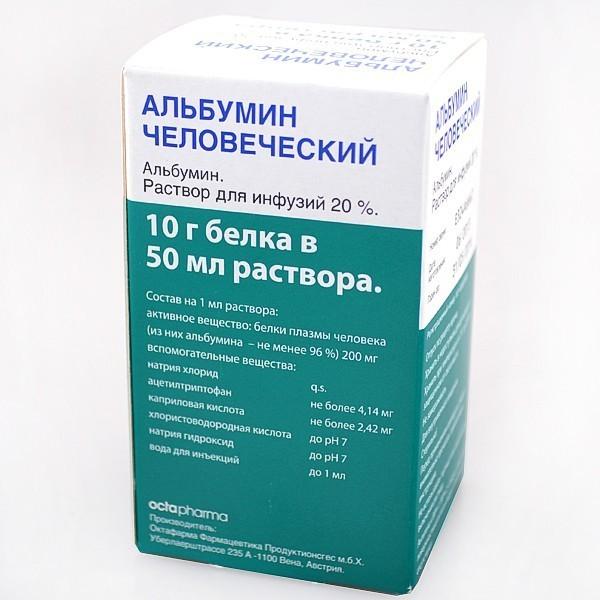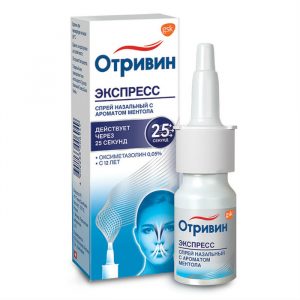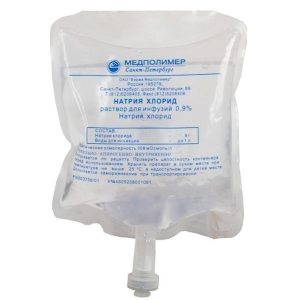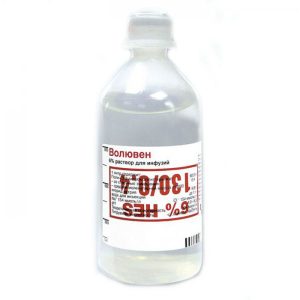Description
Release form
Infusion solution 20% clear, from almost colorless to light yellow, yellow or light green.
Packaging
50 ml – glass bottles (1) with holder – packs of cardboard.
Pharmacological action of
In quantitative terms, human albumin represents more than half of the total plasma protein, accounting for approximately 10% of the protein-synthesizing activity of the liver.
Human albumin has a corresponding hyperoncotic effect. The most important physiological functions of albumin are related to its contribution to the regulation of oncotic blood pressure, as well as to transport function. Albumin stabilizes the volume of circulating blood and is a carrier of hormones, enzymes, drugs and toxins.
Pharmacokinetics
Normally, the total exchange pool of albumin is 4-5 g / kg body weight, with 40-45% being intravascular and 55-60% in the tissues. Under conditions such as severe burns or septic shock, increased capillary permeability alters the kinetics of albumin and may cause its abnormal distribution. Normally, the average T1 / 2 of albumin is about 19 days. The balance between synthesis and cleavage of albumin is usually achieved through a feedback mechanism. The elimination process is carried out mainly intracellularly under the action of lysosomal proteases.
In healthy people, less than 10% of the injected iv albumin leaves the intravascular space within the first 2 hours. There is significant individual variability in the effect of albumin infusion on plasma volume. In some patients, blood plasma volume may remain increased for several hours. However, in critically ill patients, albumin can leave the bloodstream in significant quantities and at an unpredictable rate.
Preclinical safety data
Human albumin is a natural component of human plasma and acts similarly to physiological albumin.
A single dose toxicity study in animals is of little importance and does not allow an assessment of the toxic or lethal dose or the relationship of dose and effect.
Animal toxicity studies of multiple doses are not feasible due to the formation of antibodies to a heterogeneous protein.
There is currently no evidence regarding fetal and fetal toxicity, carcinogenic and mutagenic effects of human albumin. Animal studies also showed no signs of acute toxicity.
Contraindications
allergic reaction to albumin or any of the excipients.
Human albumin solutions must not be diluted with water for injection, as this can cause hemolysis in recipients. There is a risk of hemolysis with a potentially fatal outcome, as well as a risk of acute renal failure due to the inadmissible use of sterile water for injection for human Albumin dilution.
Caution Albumin human should be used in conditions in which hypervolemia and its consequences or hemodilution may present a particular risk to the patient. Examples of such conditions are decompensated heart failure, hypertension, varicose veins, pulmonary edema, hemorrhagic diathesis, severe anemia, renal and postrenal failure.
Use in cases of impaired renal function
Caution Albumin Human should be used in conditions in which hypervolemia and its consequences or hemodilution may present a particular risk to the patient. Examples of such conditions are: renal and postrenal failure.
Use in children
The safety and effectiveness of the human Albumin solution in pediatric patients has not been established, however, there are no additional risks to the use of this drug in children, other than the risks that exist when it is used in adults.
Pregnancy and lactation
There are no data on the use of human albumin in pregnant women and during lactation. Before prescribing the drug in each case, doctors should carefully evaluate the potential risks and benefits of using human albumin.
Special instructions
Allergic reactions / anaphylactic shock
Any suspicion of an allergic or anaphylactic reaction requires immediate discontinuation of the drug. In case of shock, standard anti-shock therapy should be used.
Since this drug is made from human blood plasma, it may carry the risk of transmission of pathogens, such as viruses and, theoretically, the causative agent of Creutzfeldt-Jakob disease. This also applies to unknown or new viruses and other pathogens.
The risk of transmission of infectious agents has been reduced by screening plasma donors for possible infection with certain viruses in the past, by testing for the presence of certain viral infections at present, and by inactivating and / or removing certain viruses. The measures taken are considered effective for enveloped viruses such as HIV, hepatitis B virus, hepatitis C virus, as well as for enveloped viruses such as hepatitis A virus and parvovirus B19. Each time Albumin is administered to a human patient, it is strongly recommended to record the name and series number of the drug in order to establish a relationship between the patient and the series of the drug.
Hemodynamics
Do not administer hemodynamic parameters without careful monitoring, monitor the development of symptoms of heart or respiratory failure, renal failure, or increased intracranial pressure.
Hypervolemia / hemodilution
Human albumin should be used with caution in conditions in which hypervolemia and its consequences or hemodilution may present a particular risk to the patient. Examples of such conditions are decompensated heart failure, hypertension, varicose veins, pulmonary edema, hemorrhagic diathesis, severe anemia, renal and postrenal failure. The rate of administration should be selected in accordance with the concentration of the solution and the hemodynamic parameters of the patient. Rapid administration can lead to circulatory overload and pulmonary edema. At the first clinical signs of an overload of the cardiovascular system (headache, shortness of breath, blockage of the jugular veins) or an increase in blood pressure, an increase in pressure in the central vein and pulmonary edema, the drug should be stopped immediately.
Use in pediatric practice
The safety and efficacy of human Albumin solution in pediatric patients has not been established, however, there are no additional risks associated with the use of this drug in children, other than those associated with its use in adults.
Large volumes
When replacing relatively large volumes, it is necessary to control the parameters of the coagulation system and the hematocrit level. It is necessary to ensure adequate replacement of other blood components (coagulation factors, electrolytes, platelets and red blood cells). It is necessary to strictly monitor hemodynamic parameters.
Electrolyte status
With the introduction of human Albumin, the electrolyte status of the patient should be monitored and the necessary measures taken to restore and maintain the balance of electrolytes.
Blood pressure
The increase in blood pressure after infusion of Albumin human necessitates careful monitoring of the patient after an injury or after surgery to detect and treat damaged vessels that might not bleed at lower blood pressure.
Application, Handling and disposal
Human Albumin Solution should not be mixed with other drugs, including with whole blood and blood components, however, it can be used as a concomitant, if it is medically appropriate.
Do not use if the solution is cloudy or if the vial is not tight. Preparations for parenteral administration before use should be visually examined for mechanical impurities and discoloration, if the solution and container allow this to be done. If leaks are found, the drug must be discarded.
There is a risk of hemolysis with potentially fatal consequences, as well as a risk of acute renal failure when using sterile water for injection to dilute human albumin with a concentration of 20% or higher. Recommended solvents include 0.9% sodium chloride or 5% dextrose in water.
Influence on the ability to drive vehicles and control mechanisms
There is no data on the influence of human Albumin on the ability to drive a car and work with other machines and mechanisms.
Composition of
1 ml
human plasma proteins 200 mg,
? incl. albumin manan less than 96%
Excipients: sodium chloride, acetyltryptophan, caprylic acid, hydrochloric acid, sodium hydroxide, water d / and.
Dosage and administration
The dose of human albumin solution is determined individually. With the introduction of Albumin human, hemodynamic parameters and patient respiration should be monitored to prevent pulmonary edema. In addition, the patient s neurological status should be monitored to prevent an increase in intracranial pressure.
A solution of human albumin should be administered iv. The solution of human albumin should not be mixed with other drugs, including whole blood and blood components, however, it can be used as a concomitant if it is medically feasible.
The solution of human albumin cannot be diluted with water for injection, as this can cause hemolysis in patients. The solution of human albumin cannot be mixed with protein hydrolysates or solutions containing alcohol, because such combinations can precipitate proteins.
Do not add other medicines.
If the dose and rate of administration are not selected taking into account the concentration of the solution and the clinical status of the patient, administration of human Albumin can lead to hypervolemia.
In patients receiving human albumin, hemodynamic parameters must be monitored to prevent hypervolemia and cardiovascular overload.
Adverse effects
Adverse adverse reactions according to clinical trials
There are no data on adverse reactions in controlled clinical trials of Albumin human.
Adverse Adverse Events Reported in the Post-Marketing Period
The following adverse adverse reactions were reported in the post-marketing period. These reactions are listed by organ system class (SOC) using the preferred terms of the Medical Dictionary of Regulatory Activities (MedDRA) in descending order of severity:
From the immune system: anaphylactic shock, anaphylactic reactions, hypersensitivity / allergic reactions.
From the side of the central nervous system: headache.
From the cardiovascular system: if it is necessary to use the drug during lactation, the issue of stopping breastfeeding tachycardia, lowering blood pressure, and flushing should be resolved.
From the respiratory system: shortness of breath.
From the digestive system: vomiting, nausea, dysgeusia.
From the skin: urticaria, rash, itching.
Local reactions: fever, chills.
Drug Interactions
No studies of human Albumin interaction with other drugs have been performed (unknown due to lack of relevant data in clinical studies, medical literature, and safety reports).
Overdose
Significant overdose and increased administration rate can lead to hypervolemia.
Storage conditions
Store the product at 2 ° to 25 ° C. Do not freeze. Keep out of reach of children
Shelf life
3 years. Do not use after expiration date, indicated on the packaging
Deystvuyushtee substance
Alybumin per person
Dosage form
solution for infusion
Appointment Appointment
adults, For children prescribed by a doctor
Oktafarma AG, Austria




